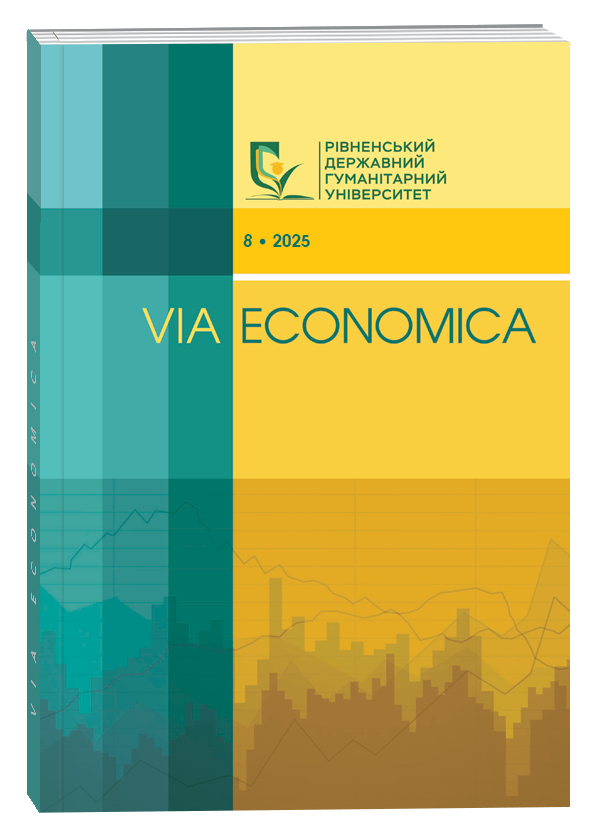THE IMPACT OF DEMOGRAPHIC STRUCTURE ON THE FORMATION OF HUMAN CAPITAL IN ENTERPRISES
Abstract
The article explores the critical influence of demographic structure on the formation of human capital within enterprises in Ukraine under conditions of socio-economic instability and war. The study emphasizes the deep interconnection between demographic indicators and the long-term sustainability of the labor force. A key focus is placed on the age-sex composition of the population, as illustrated by the demographic pyramid for January 1, 2022, which reflects several alarming trends. These include a sharp decline in the proportion of youth under the age of 14, a rapidly aging population, gender imbalances, and significant migration flows. The loss of young people, who typically possess high adaptability, digital literacy, and innovation potential, threatens the country’s ability to replenish and develop a competitive human capital base. The core of Ukraine’s current human capital consists of individuals aged 30 to 45, who are the most professionally active and technologically engaged. However, this group is expected to shrink due to the insufficient inflow of younger generations, leading to increased pressure on healthcare, education, and pension systems. In addition, migration processes—both internal displacement and mass emigration—have led to the outflow of some of the most economically active and educated segments of the population. According to the UNHCR, over 7.9 million Ukrainians have fled abroad, and another 4.9 million are internally displaced. These groups include women aged 35–59 and youth aged 18–34, who form the backbone of intellectual and managerial capital in any modern economy. Gender inequality is another important issue identified in the structure of employment. Women are significantly underrepresented in micro and small enterprises, which reduces the inclusiveness and efficiency of labor market development. Conversely, large and medium-sized enterprises demonstrate greater gender balance and better institutional conditions for talent development, thus enabling more comprehensive human capital reproduction. The article concludes that overcoming the negative consequences of demographic shifts and migration requires a coordinated state policy focused on preserving, developing, and effectively utilizing human capital. Such policy must include educational reform, support for youth and women’s participation in the labor market, and incentives to encourage demographic renewal, ensuring the resilience and innovative potential of Ukraine’s economy.
References
Підгірна В. Н., Костащук В. І., Данілова О. М. Оцінка структури та тенденції зайнятості населення України в умовах трансформаційних змін. Економіка та суспільство. 2022. № 40. С. 208–214. DOI: https://doi.org/10.32782/2524-0072/2022-40-61
Судаков М., Лісогор Л. Ринок праці України 2022–2023: стан, тенденції та перспективи / Державна служба зайнятості України, Федерація роботодавців України, Міністерство освіти і науки України, Європейський банк реконструкції та розвитку, Фонд міжнародної солідарності (Solidarity Fund PL). Київ, 2023. 166 с.
Дослідження на ґрунті даних про підконтрольну територію України (2 лютого 2023 р.) // Опендатабот. URL: https://opendatabot.ua/analytics/death-2022
Ukraine Refugee Situation / UNHCR. Operational Data Portal. URL: https://data.unhcr.org/en/situations/ukraine
Profiles, Needs & Intentions of Refugees from Ukraine: Regional protection profiling & monitoring factsheet. UNHCR, Dec. 2022. URL: https://www.ecoi.net/en/file/local/2084454/Regional+Ukraine+Protection+Profiling+Factsheet+2022.pdf
Македон В. В., Мячин В. Г. Трансформація управління персоналом під впливом технологій штучного інтелекту. Інфраструктура ринку. 2025. Вип. 83. С. 214–219. DOI: https://doi.org/10.32782/infraestructura.83-28
Makedon V., Budko O., Salyga K., Myachin V., Fisunenko N. Improving Strategic Planning and Ensuring the Development of Enterprises Based on Relational Strategies. Theoretical And Practical Research In Economic Fields. 2024. No 15(4). Pp. 798–811. DOI: https://doi.org/10.14505/tpref.v15.4(32).02
Makedon V., Korneyev M. Improving methodology of estimating value of financial sector entities dealing in mergers and acquisitions. Investment Management and Financial Innovations. 2014. No 11(1). pp. 44–55. URL: https://www.researchgate.net/publication/289853616_Improving_methodology_of_estimating_value_of_financial_sector_entities_dealing_in_mergers_ and_acquisitions
Makedon V., Myachin V., Plakhotnik O., Fisunenko N., Mykhailenko O. Construction of a model for evaluating the efficiency of technology transfer process based on a fuzzy logic approach. Eastern-European Journal of Enterprise Technologies. 2024. No 2(13(128)). P. 47–57. DOI: https://doi.org/10.15587/1729-4061.2024.300796
Копилов Д. В. Вплив технологій штучного інтелекту на процес відтворення людського капіталу підприємства. Вісник економіки. Серія «Економічні науки». 2024. Вип. 3(107). С. 62–70. DOI: https://doi.org/10.31713/ve320247
Pidgirna, V. N., Kostashchuk, V. I., & Danilova, O. M. (2022). Otsinka struktury ta tendentsii zainiatosti naselennia Ukrainy v umovakh transformatsiinykh zmin [Assessment of the structure and trends of employment in Ukraine under transformational changes]. Ekonomika ta suspilstvo, (40), 208–214. DOI: https://doi.org/10.32782/2524-0072/2022-40-61
Sudakov, M., & Lisohor, L. (2023). Rynok pratsi Ukrainy 2022–2023: stan, tendentsii ta perspektyvy [Ukraine’s labor market 2022–2023: status, trends, and prospects]. Kyiv: Derzhavna sluzhba zainiatosti Ukrainy, 166 p.
Opendatabot. (2023). Doslidzhennia na hrunti danykh pro pidkontrolnu terytoriiu Ukrainy [Study based on data about the government-controlled territory of Ukraine]. Available at: https://opendatabot.ua/analytics/death-2022
UNHCR. (2023). Ukraine Refugee Situation / Operational Data Portal. Available at: https://data.unhcr.org/en/situations/ukraine
UNHCR. (2022). Profiles, Needs & Intentions of Refugees from Ukraine: Regional protection profiling & monitoring factsheet. December 2022. Available at: https://www.ecoi.net/en/file/local/2084454/Regional+Ukraine+Protection+Profiling+Factsheet+2022.pdf
Makedon, V. V., & Myachin, V. H. (2025). Transformatsiia upravlinnia personalom pid vplyvom tekhnolohii shtuchnoho intelektu [Transformation of personnel management under the influence of artificial intelligence technologies]. Infrastruktura rynku, (83), 214–219. DOI: https://doi.org/10.32782/infraestructura.83-28
Makedon, V., Budko, O., Salyga, K., Myachin, V., & Fisunenko, N. (2024). Improving strategic planning and ensuring the development of enterprises based on relational strategies. Theoretical And Practical Research In Economic Fields, 15(4), 798–811. DOI: https://doi.org/10.14505/tpref.v15.4(32).02
Makedon, V., & Korneyev, M. (2014). Improving methodology of estimating value of financial sector entities dealing in mergers and acquisitions. Investment Management and Financial Innovations, 11(1), 44–55. Available at: https://www.researchgate.net/publication/289853616_Improving_methodology_of_estimating_value_of_financial_sector_entities_dealing_in_mergers_and_acquisitions
Makedon, V., Myachin, V., Plakhotnik, O., Fisunenko, N., & Mykhailenko, O. (2024). Construction of a model for evaluating the efficiency of technology transfer process based on a fuzzy logic approach. Eastern-European Journal of Enterprise Technologies, 2(13(128)), 47–57. DOI: https://doi.org/10.15587/1729-4061.2024.300796
Kopylov, D. V. (2024). Vplyv tekhnolohii shtuchnoho intelektu na protses vidtvorennia liudskoho kapitalu pidpryiemstva [Impact of artificial intelligence technologies on the reproduction of human capital at the enterprise]. Visnyk ekonomiky. Seriia «Ekonomichni nauky», 3(107), 62–70. DOI: https://doi.org/10.31713/ve320247


